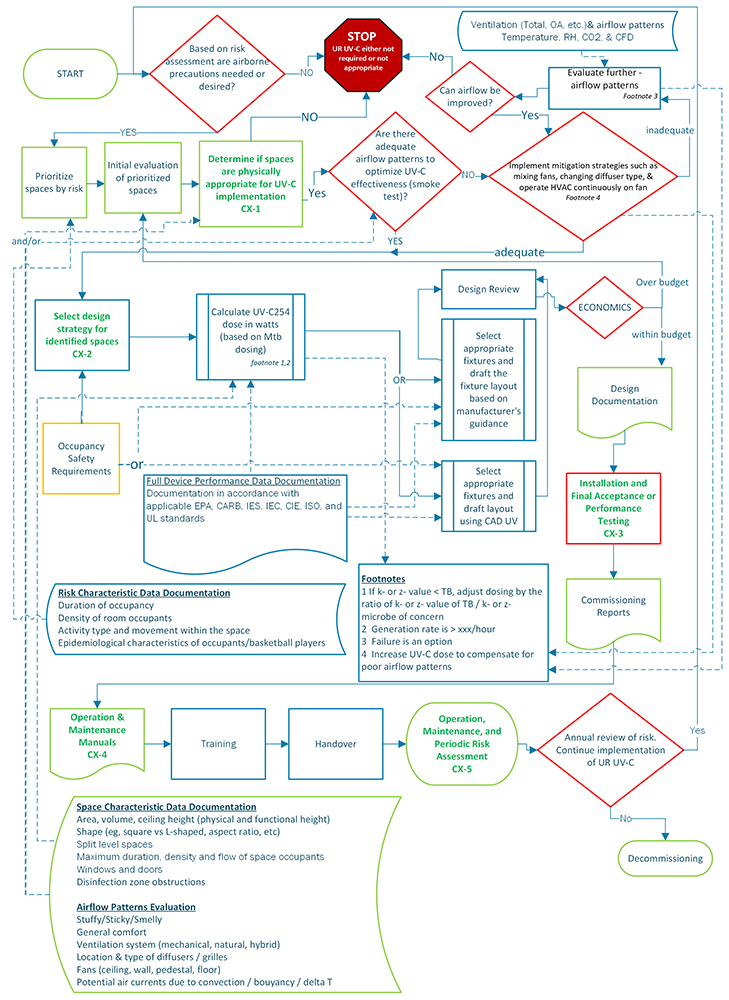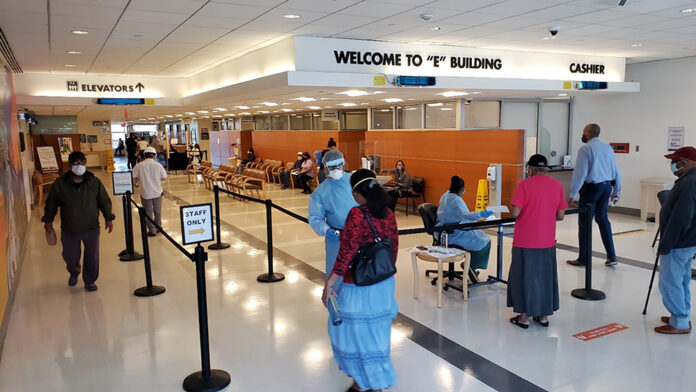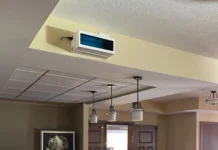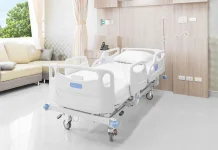By contributing authors Richard L. Vincent, MS, FIES, LEED-AP, administrative manager, Icahn School of Medicine at Mount Sinai; Paul Arthur Jensen, Ph.D., PE, CIH, consultant and co-founder, Final Approach, Inc.; Bill Palmer, vice president, AeroMed Technologies LLC; Katja Auer, MA, MBA, CMIP, clinical director – Healthcare Solutions, American Ultraviolet; Ashish Mathur, Ph.D., vice president, Innovation & Technology, Ultraviolet Devices
Upper-room (UR) UV-C254 (also referred to as Germicidal Upper Room – GUV – or Ultraviolet Germicidal Irradiation – UVGI) systems can be safely and effectively deployed to disinfect large volumes of air in occupied spaces, reducing transmission of airborne microbes (e.g., SARS-CoV-2, influenza virus, tubercle bacilli and measles virus). Historically, UR UV-C254 has been used since the 1940s in high-risk settings, e.g., TB wards in hospitals, homeless shelters, microbiology labs and in schools to prevent the spread of measles. Since the COVID-19 pandemic, UR UV-C254 has seen wider applications in office buildings, schools, nursing and long-term care facilities, places of worship, museums, airports, restaurants, spas and numerous other environments where people congregate. A lot of environments can easily be retrofitted with UR UV-C254, lending themselves to the expansion of its applications.
UR UV-C254 augments ventilation by producing equivalent air disinfection as if increased normal ventilation air changes were added to dilute concentrations of infectious microorganisms and viruses. UR UV-C254 is recommended by WHO (2019), CDC (NIOSH 2009) and IES (IES: RP 24 2021 RP 27.1 2022).
Purpose and Scope of GPC 37 Guideline
ASHRAE GPC 37 committee is developing guidelines to provide minimum requirements for safe and effective implementation of upper-room UV-C254 systems for air disinfection. The guidelines describe best practices for assessing need, in context of other airborne infection control measures, understanding what is necessary for commissioning, design, installation and maintenance and operation. In this article, highlights of guidelines for training application personnel are presented to provide UR UV-C254 solutions that are sustainable, effective and safe. The authors anticipate that these guidelines will be released in 2023.
Upper-Room UV-C254 Systems as a strategy for air disinfection
Upper-room (UR) UV-C254 systems are composed of two major components: 1) a UV-C254 which emits high UV-C254 irradiance in the upper room and safe levels of UV-C254 in the occupied space; 2) a means to move air from the occupied space to the upper room (irradiated zone) and back again to the occupied space. It may take several passes of air through the upper room before the airborne microbes receive sufficient UV-C254 dose to inactivate them. These systems generally are used to augment existing heating, ventilating and air-conditioning (HVAC) systems. UR UV-C254 systems help reduce the concentration of infectious airborne microbes when there is no HVAC system or when the HVAC system does not provide sufficient dilution or recirculates 100% of exhausted air in the building. In some cases, the HVAC system fans and appropriate diffusers may be the source for movement of air. In other cases, mixing fans or other means to move the air in the space must be added.
Ventilation often is described in terms of air exchange rates (air changers per hour, ACH) or volumetric airflow rates (cfm or m3/h). Note that ACH should be based on the clean air delivered to the room. For example, if the airflow rate into a 1,000 ft3 (28 m3) room is 200 cfm (340 m3/h) and the system is 70% recirculating (30% fresh air), the Clean Air Delivery Rate (CADR) to the room is 60 cfm (100 m3/h) and the ACH is 3.6 ACH (60 cfm * 60 min/h/1000 ft3). When dealing with UV-C and microorganisms, the terms equivalent ACH (eACH) or equivalent CADR (eCADR) are used. In other words, it would take the same amount of ventilation with outside air to give the equivalent or same ACH and CADR provided by the inactivation of microbes due to the UR UV-C254 system. Note that the eACH and eCADR is microbe specific due to the varied susceptibility to UV-C254.
Rationale for Risk Assessment and Space Assessment
The decision to install interventions such as UR UV-C254 is based on a desire to reduce the risk of transmission of airborne infectious microbes by lowering their concentration in the space. Risk is determined by the microorganism of concern and by the population present in the space. Are the microorganisms common in the general population and is the population within your space susceptible to those microorganisms? Other considerations are density of room occupants and the presence of other interventions such as ventilation and air filtration that may serve to further reduce microorganism concentration and subsequent risk. Additionally, the activities that occur within a space, such as singing, talking, coughing and exercising, also may elevate risk of transmission. Individual settings such as offices where meetings usually are not held are considered to be of lower risk.
 Streamline Guidance – Commissioning Flow Chart
Streamline Guidance – Commissioning Flow Chart
The Commissioning process is embedded in the GPC 37 Guideline (ANSI/ASHRAE/IES 202 and 90.1) which states, “commissioning is a quality-focused process for enhancing the delivery of a project” that focuses upon verifying and documenting that a project is “planned, designed, installed, tested, operated and maintained to meet the Owner’s Project Requirement.” The proposed commissioning design flowchart (see Figure 1, Draft November 2022) maps the entire commissioning process from needs assessment to implementation to build the project brief. The process allows for risk assessment and space assessment leading to a-go or no-go for a UR UV-C254 solution. The commissioning step (denoted as CX) on the flowchart elements indicates the steps related to 1) Pre-Design, 2) Design, 3) Construction/Installation, 4) Acceptance/Operations and 5) Post-Installation Phase.
Dosing Criteria
Dosing strategies of UV-C254 systems is a function of the UV-C254 output of the luminaire, the ability to irradiate the upper room relatively uniformly, and the movement of air from the occupied space to the irradiated zone and back to the occupied space. GPC 37 recommends the use of the area or volume of the occupied space to determine the minimum applied UV-C254 dose. A minimum dose of 0.34 mW/ft3 (12 mW/m3) is recommended based on volume while a minimum dose of 0.031 mW/ft2 (0.33 mW/m2) is recommended when based on the area of the occupied space (Mphahlele [2009], Nardell [2021], Jensen [2021]). Note that these criteria are based on M. tuberculosis (Mtb). In some situations, a client might request a UV-C254 system for a microbe that has lower or greater susceptibility to UV-C254 than Mtb. In either case, one would multiply the UV rate constant (k-value or z-value) of the Mtb by the UV rate constant of microbe of interest. If operating in a high-humidity environment (>70% RH), the dosing criteria should be increased 50-70%.
Safety Guidance and Measurement
GPC 37 includes recommendations on how, when and where to take UV-C254 safety measurements. Examples and illustrations also are shown in the guideline. While there are no known long-term health risks associated with accidental exposure to UV-C254 light, safety testing remains an important component of responsible application of UV-C254. There are three types of safety tests that should be done on all UR UV-C254 luminaires, namely electrical safety, photobiological safety and confirmation of ozone free operation.
Once the selection and installation process is completed, all UR UV-C254 installations should be tested and confirmed safe for room occupants, to ensure UV-C254 exposure will not result in excessive eye and skin exposure. Even UV-C254 luminaires bearing a Risk Group Exempt rating may be result in overexposure of occupants if not selected and installed properly. Field testing is needed as there may exist room conditions that reflect or redirect the UV energy into the occupied space.
The American Conference of Governmental Industrial Hygienists (ACGIH 2022) has set the UV-C254 Threshold Limit Value (TLV®) as 6,000 µJ/cm2 for eye exposure and 10,000 µJ/cm2 for skin exposure, over an eight-hour exposure time. Generally, the TLV for eye exposure is used as a conservative approach. Actual eye exposure is a function of the UV-C254 irradiance level present at eye height, the amount of time exposed to UV-C254, and the amount of UV-C254 that is prevented from entering the eye. The use of a field of view (FOV) cone (±40°) attached to the UV detector, mimics the protection afforded to the eye by typical human facial structure and has shown a reduction in actual exposure of 18-34% from the levels measured with the detector alone (Milonova, 2016). Additionally, one study conducted by First (2005), showed that room occupants, at the most, had an actual UV-C254 exposure of less than 31% of the TLV®; however, one must assess each setting to ensure the occupants are not overexposed.
It has been standard practice in healthcare settings where UR UV-C254 is applied to use 0.40 µW/cm2 as a conservative irradiance level for eye-exposure measurement over an eight-hour period. This level of exposure is well below the capability of some UV-C254 meters found for sale. Therefore, great care must be taken in the selection of UV-C254 radiometers and detectors to ensure they can accurately measure these low levels for safety. UV-C254 detectors should use a FOV cone for eye level measurements and should be calibrated with a NIST-traceable standard as recommended by the manufacturer or on an annual basis.
UV-C254 safety readings should be taken by a trained individual when UV-C254 luminaires are installed, maintenance performed and annually to ensure ongoing occupant safety.
Equipment Certification: UL Standards
Photobiological safety testing is done as part of the UL1598 certification and in compliance with UL 8802 (proposed) test standard. It verifies an installation height and angle at which the luminaire falls into various risk groups. These risk groups are related to eye and skin safety for room occupants. For instance, an UR UV-C254 luminaire that is in Risk Group Exempt may be used for eight-hour exposure periods without any safeguards if installed and maintained per manufacturer’s instructions. A luminaire with a Risk Group 1 rating only may be used for periods of less than three hours and Risk Group 2 users would be limited to less than 30 minutes of exposure. Additionally, Risk Group 1 and 2 usage would require instructional safeguards.
The US EPA has determined that even small amounts of ozone in indoor air can be harmful to human health. Some UV light sources, especially those at the lower end of the UV-C spectrum, may produce ozone. To ensure that UVC sources used in UR UV-C254 luminaires do not generate ozone, all UR UV-C254 designs shall be tested in compliance with UL standard UL 2998 to show zero ozone generation.
All of the above testing shall be performed by a NRTL (Nationally Recognized Testing Laboratory) such as Intertek or Underwriters Laboratory. Each luminaire shall be labeled in compliance with each of these standards. All such luminaires shall be manufactured in an EPA registered establishment.
Planning tools
CAD lighting software is available to plan UR UV-C systems with the same ease as general lighting systems such as Visual™ Lighting (Acuity Brands Lighting) and Relux® UVC (Signify). IES LM-58 and CIE 247:2021 (CIE Guide for the Gonioradiometric Measurement of Upper Air Ultraviolet Germicidal Irradiation Luminaires) are used as a basis to promote uniformity and accuracy in the measurement of UV-C254 luminaires. Test report data is exportable to any standard electronic data file formats for use in lighting software programs adapted for UV-C254 application. Test report data allow comparison of different UR UV-C254 luminaires (louvered, open) total emitted UV-C254 in watts and the 3-D distribution of UV-C254 energy.
A benefit of this approach are the allowance for summation of overlapping UV energy to be considered to provide a uniform level of UV-C254 in a space. The programs allow adjustments for different surface reflectances, ceiling heights, UV-C wavelengths, and estimates of eye level safety and dose, based on selected microorganisms or viruses. As with many programs, the degree of accuracy needs to be considered; these planning tools allow trial of different configurations and to quickly update as built installations. CAD results cannot replace actual field measurements which are a part of the commissioning process. Installations must be verified by measurement in the field and adjusted for performance and safety.
Training and Certifications
An urgent need for the UV-C industry is the development of a cadre of technicians and professionals to design layouts, provide installations, conduct preventive and routine maintenance, and perform testing and safety validation of upper-room and whole-room UV-C systems. Additionally, there is a need for a clearinghouse or certification program. With the support of the National Association of Lighting Management Companies (NALMCO) and supplement funding from the Balvi Foundation through the University of Maryland, an educational program (didactic and practice-based), including a certification program, are in the process of being developed. The UV-C educational program will parallel the NALMCO certification program. The goal is to complete the Certified Apprentice UV-C Technician and the Certified Senior UV-C Technician educational programs by March 2023 and the Certified UV-C Controls Professional and the Certified UV-C Management Consultant programs by October 2023. For more information on NALMCO, visit www.nalmco.org.
Future Work/Recommendations
GPC 37 version 1.0:2023 is currently based on UV-C254. It is anticipated that the basic principles to update the GPC 37 guidelines as other UV-C sources and wavelengths become available for use in an UR UV-C configuration. Hybrid systems of general lighting and UV-C are being developed for both upper-room and direct UV-C applications. New training programs are being developed using GPC 37 as a primary reference for proper and safe implementation of UR UV-C254 systems.
References
American Conference of Governmental Industrial Hygienists (ACGIH). 2023 Threshold Limit Values (TLVs®) and Biological Exposure Indices (BEIs®). ACGIH: Cincinnati, OH.
First MW, Weker RA, Yasui S, Nardell EA. Monitoring human exposures to upper-room germicidal ultraviolet irradiation. J Occup Environ Hyg. 2005 May;2(5):285-92. doi: 10.1080/15459620590952224. PMID: 15848970.
Jensen PA. Critical Design Parameters in Design and Efficacy of Upper-Room UVC254 Luminaire Systems: Part I: Overview of Major Parameters and Relationships†. Photochem Photobiol. 2021 May;97(3):532-541. doi: 10.1111/php.13425. Epub 2021 Apr 25. PMID: 33786838; PMCID: PMC8250746.
Mphahlele M, Dharmadhikari AS, Jensen PA, Rudnick SN, van Reenen TH, Pagano MA, Leuschner W, Sears TA, Milonova SP, van der Walt M, Stoltz AC, Weyer K, Nardell EA. Institutional Tuberculosis Transmission. Controlled Trial of Upper Room Ultraviolet Air Disinfection: A Basis for New Dosing Guidelines. Am J Respir Crit Care Med. 2015 Aug 15;192(4):477-84. doi: 10.1164/rccm.201501-0060OC. PMID: 25928547; PMCID: PMC4595666.
Nardell EA. Air Disinfection for Airborne Infection Control with a Focus on COVID-19: Why Germicidal UV is Essential†. Photochem Photobiol. 2021 May;97(3):493-497. doi: 10.1111/php.13421. Epub 2021 Apr 5. PMID: 33759191; PMCID: PMC8251047.
Milonova S, Rudnick S, McDevitt J, Nardell E. Occupant UV exposure measurements for upper-room ultraviolet germicidal irradiation. J Photochem Photobiol B. 2016 Jun;159:88-92. doi: 10.1016/j.jphotobiol.2016.03.009. Epub 2016 Mar 11. PMID: 27038734; PMCID: PMC4854786.
Standards
ANSI/ASHRAE/IES Standard 90.1. Energy Standard for Buildings Except Low-Rise Residential Buildings
ANSI/ASHRAE/IES Standard 202. Commissioning Process for Buildings and Systems
ANSI/IES RP-44. Recommended Practice: Ultraviolet Germicidal Irradiation (UVGI)
ANSI/IES 29.1. Recommended Practice for Photobiological Safety for Lamps and Lamp Systems –General Requirements
CIE 247. Guide for the Gonioradiometric Measurement of Upper Air Ultraviolet Germicidal Irradiation Luminaires
IES LM-58. Approved Method: Spectroradiometric Measurement Methods for Light Sources
UL 867. Electrostatic Air Cleaners
UL1598. UL Standard for Safety Luminaires.
UL 2998. Environmental Claim Validation Procedure (ECVP) for Zero Ozone Emissions from Air Cleaners
UL 8802 (proposed). UV Germicidal Equipment and System






